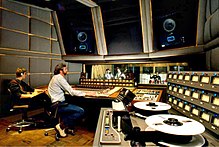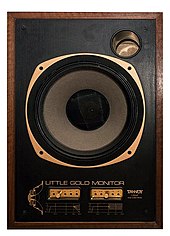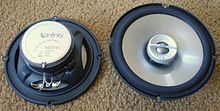
A loudspeaker is a combination of one or more speaker drivers, an enclosure, and electrical connections. The speaker driver is an electroacoustic transducer that converts an electrical audio signal into a corresponding sound.

Audio crossovers are a type of electronic filter circuitry that splits an audio signal into two or more frequency ranges, so that the signals can be sent to loudspeaker drivers that are designed to operate within different frequency ranges. The crossover filters can be either active or passive. They are often described as two-way or three-way, which indicate, respectively, that the crossover splits a given signal into two frequency ranges or three frequency ranges. Crossovers are used in loudspeaker cabinets, power amplifiers in consumer electronics and pro audio and musical instrument amplifier products. For the latter two markets, crossovers are used in bass amplifiers, keyboard amplifiers, bass and keyboard speaker enclosures and sound reinforcement system equipment.
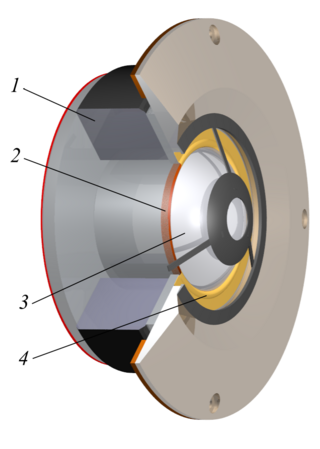
A tweeter or treble speaker is a special type of loudspeaker that is designed to produce high audio frequencies, typically up to 100 kHz. The name is derived from the high pitched sounds made by some birds (tweets), especially in contrast to the low woofs made by many dogs, after which low-frequency drivers are named (woofers).
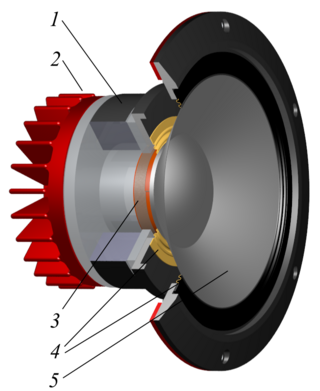
A mid-range speaker is a loudspeaker driver that reproduces sound in the frequency range from 250 to 2000 Hz.
A woofer or bass speaker is a technical term for a loudspeaker driver designed to produce low frequency sounds, typically from 20 Hz up to a few hundred Hz. The name is from the onomatopoeic English word for a dog's deep bark, "woof". The most common design for a woofer is the electrodynamic driver, which typically uses a stiff paper cone, driven by a voice coil surrounded by a magnetic field.

A horn loudspeaker is a loudspeaker or loudspeaker element which uses an acoustic horn to increase the overall efficiency of the driving element(s). A common form (right) consists of a compression driver which produces sound waves with a small metal diaphragm vibrated by an electromagnet, attached to a horn, a flaring duct to conduct the sound waves to the open air. Another type is a woofer driver mounted in a loudspeaker enclosure which is divided by internal partitions to form a zigzag flaring duct which functions as a horn; this type is called a folded horn speaker. The horn serves to improve the coupling efficiency between the speaker driver and the air. The horn can be thought of as an "acoustic transformer" that provides impedance matching between the relatively dense diaphragm material and the less-dense air. The result is greater acoustic output power from a given driver.
Klipsch Audio Technologies is an American loudspeaker company based in Indianapolis, Indiana. Founded in Hope, Arkansas, in 1946 as 'Klipsch and Associates' by Paul W. Klipsch, the company produces loudspeaker drivers and enclosures, as well as complete loudspeakers for high-end, high-fidelity sound systems, public address applications, and personal computers.

JBL is an American audio equipment manufacturer headquartered in Los Angeles, California. The company was founded in 1946 by James Bullough Lansing, an American audio engineer and loudspeaker designer. JBL currently serves the home and professional audio markets. Their professional products include live PA systems, studio monitors, and loudspeakers for cinema. Their home products include home audio speakers, waterproof Bluetooth speakers, and high-end car audio. JBL is owned by Harman International, a subsidiary of Samsung Electronics.
Altec Lansing, Inc. is an American audio electronics company founded in 1927. Their primary products are loudspeakers and associated audio electronics for professional, home, automotive and multimedia applications.

Powered speakers, also known as self-powered speakers and active speakers, are loudspeakers that have built-in amplifiers. Powered speakers are used in a range of settings, including in sound reinforcement systems, both for the main speakers facing the audience and the monitor speakers facing the performers; by DJs performing at dance events and raves; in private homes as part of hi-fi or home cinema audio systems and as computer speakers. They can be connected directly to a mixing console or other low-level audio signal source without the need for an external amplifier. Some active speakers designed for sound reinforcement system use have an onboard mixing console and microphone preamplifier, which enables microphones to be connected directly to the speaker.
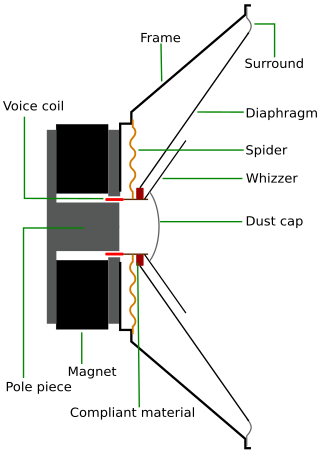
A full-range loudspeaker drive unit is defined as a driver which reproduces as much of the audible frequency range as possible, within the limitations imposed by the physical constraints of a specific design. The frequency range of these drivers is maximized through the use of a whizzer cone and other means. Most single driver systems, such as those in radios, or small computer speaker designs, cannot reproduce all of the audible frequencies or the entire audible audio range.

Acoustic Research was a Cambridge, Massachusetts-based company that manufactured high-end audio equipment. The brand is now owned by VOXX. Acoustic Research was known for the AR-3 series of speaker systems, which used the 12 in (300 mm) acoustic suspension woofer of the AR-1 with newly designed dome mid-range speaker and high-frequency drivers. AR's line of acoustic suspension speakers were the first loudspeakers with relatively flat response, extended bass, wide dispersion, small size, and reasonable cost. The AR Turntable remains a highly sought vinyl record player.
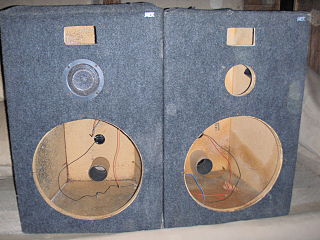
A loudspeaker enclosure or loudspeaker cabinet is an enclosure in which speaker drivers and associated electronic hardware, such as crossover circuits and, in some cases, power amplifiers, are mounted. Enclosures may range in design from simple, homemade DIY rectangular particleboard boxes to very complex, expensive computer-designed hi-fi cabinets that incorporate composite materials, internal baffles, horns, bass reflex ports and acoustic insulation. Loudspeaker enclosures range in size from small "bookshelf" speaker cabinets with 4-inch (10 cm) woofers and small tweeters designed for listening to music with a hi-fi system in a private home to huge, heavy subwoofer enclosures with multiple 18-inch (46 cm) or even 21-inch (53 cm) speakers in huge enclosures which are designed for use in stadium concert sound reinforcement systems for rock music concerts.

Studio monitors are loudspeakers in speaker enclosures specifically designed for professional audio production applications, such as recording studios, filmmaking, television studios, radio studios and project or home studios, where accurate audio reproduction is crucial. Among audio engineers, the term monitor implies that the speaker is designed to produce relatively flat (linear) phase and frequency responses. In other words, it exhibits minimal emphasis or de-emphasis of particular frequencies, the loudspeaker gives an accurate reproduction of the tonal qualities of the source audio, and there will be no relative phase shift of particular frequencies—meaning no distortion in sound-stage perspective for stereo recordings. Beyond stereo sound-stage requirements, a linear phase response helps impulse response remain true to source without encountering "smearing". An unqualified reference to a monitor often refers to a near-field design. This is a speaker small enough to sit on a stand or desk in proximity to the listener, so that most of the sound that the listener hears is coming directly from the speaker, rather than reflecting off walls and ceilings. Monitor speakers may include more than one type of driver or, for monitoring low-frequency sounds, such as bass drum, additional subwoofer cabinets may be used.
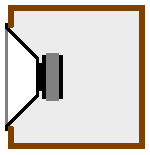
Acoustic suspension is a loudspeaker cabinet design that uses one or more loudspeaker drivers mounted in a sealed box. Acoustic suspension systems reduce bass distortion which can be caused by stiff suspensions required on drivers used for open cabinet designs.

An electrodynamic speaker driver, often called simply a speaker driver when the type is implicit, is an individual transducer that converts an electrical audio signal to sound waves. While the term is sometimes used interchangeably with the term speaker (loudspeaker), it is usually applied to specialized transducers that reproduce only a portion of the audible frequency range, or to the one or more drivers within a loudspeaker cabinet. For high fidelity reproduction of sound, multiple loudspeakers are often mounted in the same enclosure, each reproducing a different part of the audible frequency range. In this case the individual speakers are referred to as drivers and the entire unit is called a loudspeaker. Drivers made for reproducing high audio frequencies are called tweeters, those for middle frequencies are called mid-range drivers, and those for low frequencies are called woofers, while those for very low bass range are subwoofers. Less common types of drivers are supertweeters and rotary woofers.
Loudspeaker time-alignment, usually simply referred to as "time-alignment" or "Time-Align", is a term applied in loudspeaker systems which use multiple drivers to cover a wide audio range. It involves delaying the sound emanating from one or more drivers to correct the transient response, improve accuracy and, in non-coaxial drivers, improve the directivity or lobe tilting at the crossover frequencies. It employs adjusting the front-to back spacing of the individual drivers so that the sound output is truly simultaneous.

DUPLEX was the trade name given by Altec Lansing to its line of coaxial loudspeakers, beginning with the first model 601 in 1943. However, the name was most commonly associated with the subsequent model 604 which was a seminal loudspeaker that became a milestone in loudspeaker development. Well over a dozen different models carried the Duplex name over a near 50-year period. The vast majority consisted of a high frequency (HF) compression driver mounted to the back of a large diameter paper cone low frequency (LF) driver. However, there were also a few models with small diameter LF cones and direct radiator tweeters.

David W. Gunness is an American audio engineer, electrical engineer and inventor. He is known for his work on loudspeaker design, especially high-output professional horn loudspeakers for public address, studio, theater, nightclub, concert and touring uses.

In a loudspeaker, a phase plug, phasing plug or acoustical transformer is a mechanical interface between a speaker driver and the audience. The phase plug extends high frequency response because it guides waves outward toward the listener rather than allowing them to interact destructively near the driver.
